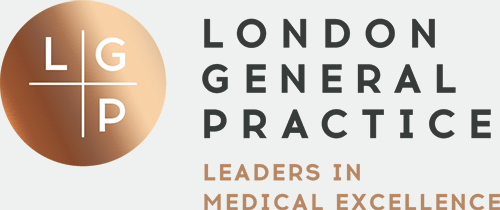HRT: A Comprehensive Guide to Hormone Replacement Therapy
October 2024
Understanding Hormone Replacement Therapy

DR ELISE DALLAS
BSC, MBCHB, MRCGP, DRCOG
GENERAL PRACTITIONER
Types of Hormones in HRT
Oestrogen: All types of HRT contain an oestrogen hormone which replaces the oestrogen that your ovaries no longer make after the menopause. HRT includes different types of oestrogen hormones, but the safest form is 17 beta estradiol which is body identical. It comes in oral or transdermal preparations. Transdermal means when oestrogen is absorbed through your skin in patches, gels, or sprays, this is the safer option as this bypasses the liver and this reduces side effects and risks.
Progesterone: All women who still have a womb and who use oestrogen replacement will also need a progestogen. Using oestrogen alone can thicken the uterine lining, leading to bleeding and an increased risk of endometrial cancer. Therefore if you have a uterus you must take progesterone to counteract this effect. If you do not have a uterus (for example if you have had a hysterectomy) then you do not need progesterone unless you had endometriosis as this means there might be some endometrial lining left in the pelvis that can be affected by oestrogen alone. The safest form of progestogen is micronised progesterone, branded as Utrogestan or Gepretix in the UK which is a body-identical regulated HRT. It is available as capsules which can be swallowed or used vaginally (off licence) and is taken at bedtime, as it can have a welcome sedative effect.
Sometimes a synthetic progestagen might be more suitable especially when bleeding is an issue. The dose of the progestogen should be proportionate to the dose of oestrogen. In the perimenopause often an intrauterine system fitted (Mirena®) is suitable as this offers protection of the endometrial protection, reduces heavy bleeding which is often an issue in perimenopause and also as a contraception also which is useful as you could still get pregnant in your perimenopause despite your hormones fluctuating.
Testosterone: In some cases, testosterone may be added to HRT once oestrogen has been started as oestrogen will help with most symptoms. It is only licensed for libido but can also improve mood, energy, stamina, motivation and is available as a gel or cream. There is not need to worry about growing a beard as we will monitor you to ensure your blood levels remain within the female range.
Vaginal Oestrogen: For localised symptoms like vaginal dryness or bladder issues, oestrogen creams, vaginal tablets, or rings can be used alongside or independently of HRT.If vaginal symptoms are the only problem, then the use of local vaginal oestrogen or dehydroepiandrostenedione (DHEA) may be preferable. Women often ask about the safety of using oestrogen. It’s reassuring to know that when you put oestrogen directly into your vagina, your body only absorbs a tiny amount. So you can use it without risk of breast cancer, blood clots, stroke or heart disease.
Find out more about our Menopause services by clicking the links below.
Choosing the Right HRT Regimen
The choice of HRT regimen depends on individual factors. If you have a womb (uterus), combined HRT with both oestrogen and progestogen is recommended to prevent uterine thickening and potential bleeding.
You will always take oestrogen continuously but the progesterone is taken either continuously or monthly depending on whether you are still having periods:
Perimenopause: if you are still having periods then you will be offered a ‘cyclical’ progesterone which should give you regular monthly withdrawal bleeds.
Postmenopause: if you are more than a year after your last period (postmenopausal), you may be offered ‘continuous’ progesterone (bleed-free HRT). You may experience some vaginal bleeding in the first 3 months, but after this it should stop. You may also be offered this regime after a year of being on cyclical HRT.
Oestrogen only HRT:
Women without a uterus (if you have had a hysterectomy) can opt for oestrogen-only HRT.
Benefits of HRT
HRT offers numerous advantages:
Symptom Relief: Most women experience significant improvement in menopausal symptoms. Hot flushes, night sweats, mood swings, and sleep disturbances typically subside. Body aches decrease, and skin and hair quality improve.
Reduced Risk of Chronic Conditions: Importantly, HRT can lower the risk of several chronic conditions that often accelerate during midlife and beyond. These benefits include:
- Osteoporosis: HRT helps protect bones from weakening due to oestrogen loss, reducing the risk of fractures.
- Cardiovascular Disease: HRT reduces the likelihood of heart problems, stroke, and vascular dementia.
- Other Diseases: Women on HRT have a lower future risk of type 2 diabetes, osteoarthritis, bowel cancer, and depression.
Understanding Risks
While HRT is generally safe and effective, there are minor risks to consider:
Breast Cancer: Combined HRT (oestrogen and progestogen) can slightly increase the risk of breast cancer, particularly with extended use. The risk diminishes after stopping HRT and is lower when using micronised progesterone. However, it’s essential to consider this risk in the context of individual factors, such as obesity and moderate alcohol consumption – both which increase the risk.
Blood Clots: In rare cases, women with a history of blood clots, liver disease, or migraines may face a small risk of clot formation with oral oestrogen. However, this risk doesn’t apply when taken through the skin in patches, gels, or sprays, making these methods safer for these women.
When to Start HRT
It is best to start taking HRT when you start to experience symptoms that have any negative impact on your quality of life. For many women this is in perimenopause, which is the time before menopause. You do not need to wait until your periods have stopped to start taking HRT. HRT is recommended as first line treatment for managing the symptoms, and for the majority of women who start HRT below the age of 60, the benefits of taking HRT outweigh the risks. However, while the most significant health benefits are seen in women who start HRT within ten years of menopause, HRT can be initiated at any age.
Hormone Tests Before Treatment
Typically, hormone tests aren’t necessary to diagnose menopause in women aged 45 or older who display menopausal symptoms. Treatment decisions are primarily based on symptom assessment. We may do other tests to see if there are other causes for your symptoms.
Starting Hormone replacement therapy
When you start taking Hormone Replacement Therapy, HRT, you might be a bit nervous. You might wonder if it is going to work and help your symptoms or will it cause side effects and you might ask how long will it take to feel better? And how on earth do I take it.
This is perfectly natural and this is why we walk you through and support you every step of your journey.
Final Thoughts
HRT offers a valuable solution for managing menopausal symptoms and reducing the risk of chronic conditions. It’s crucial to remember that the benefits of HRT outweigh the risks for most women, especially if started under the age of 60. The decision to begin HRT should be based on individual circumstances and discussed with a healthcare professional. It’s also important to note that there is no maximum duration for HRT, and it can be continued indefinitely. HRT does not delay menopause; it simply addresses its symptoms and offers long-term health benefits.
Patient resources:
Please look at our webpage with lots of information.
WHC factsheets and other helpful resources – Women’s Health Concern
At the London General Practice we screen for cancers individually or as part of one of our comprehensive health screens.
Enquire now
Web Enquiry LGP: Web Enquiry
Phone: 020 7935 1000
Email: info@thelondongeneralpractice.com
The London General Practice offers a number of screening services. To find out more about all screening services available at The London General Practice click below.
